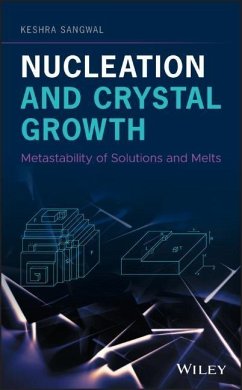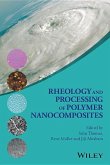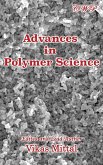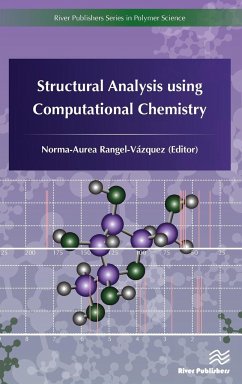- Gebundenes Buch
- Merkliste
- Auf die Merkliste
- Bewerten Bewerten
- Teilen
- Produkt teilen
- Produkterinnerung
- Produkterinnerung
A unique text presenting practical information on the topic of nucleation and crystal growth processes from metastable solutions and melts Nucleation and Crystal Growth is a groundbreaking text thatoffers an overview and description of the processes and phenomena associated with metastability of solutions and melts. The author--a noted expert in the field--puts the emphasis on low-temperature solutions that are typically involved in crystallization in a wide range of industries. The text begins with a review of the basic knowledge of solutions and the fundamentals of crystallization processes.…mehr
Andere Kunden interessierten sich auch für
![Rheology and Processing of Polymer Nanocomposites Rheology and Processing of Polymer Nanocomposites]() Rheology and Processing of Polymer Nanocomposites228,99 €
Rheology and Processing of Polymer Nanocomposites228,99 €![Advances in Polymer Science Advances in Polymer Science]() Advances in Polymer Science128,99 €
Advances in Polymer Science128,99 €![Advances in Polymer Science Advances in Polymer Science]() Advances in Polymer Science158,99 €
Advances in Polymer Science158,99 €![Essentials of Polymer Science and Engineering Essentials of Polymer Science and Engineering]() Essentials of Polymer Science and Engineering157,99 €
Essentials of Polymer Science and Engineering157,99 €![Lignin - Chemistry, Structure, and Application Lignin - Chemistry, Structure, and Application]() Lignin - Chemistry, Structure, and Application136,99 €
Lignin - Chemistry, Structure, and Application136,99 €![Cyclodextrins - Core Concepts and New Frontiers Cyclodextrins - Core Concepts and New Frontiers]() Cyclodextrins - Core Concepts and New Frontiers136,99 €
Cyclodextrins - Core Concepts and New Frontiers136,99 €![Structural Analysis using Computational Chemistry Structural Analysis using Computational Chemistry]() Structural Analysis using Computational Chemistry115,99 €
Structural Analysis using Computational Chemistry115,99 €-
-
-
A unique text presenting practical information on the topic of nucleation and crystal growth processes from metastable solutions and melts Nucleation and Crystal Growth is a groundbreaking text thatoffers an overview and description of the processes and phenomena associated with metastability of solutions and melts. The author--a noted expert in the field--puts the emphasis on low-temperature solutions that are typically involved in crystallization in a wide range of industries. The text begins with a review of the basic knowledge of solutions and the fundamentals of crystallization processes. The author then explores topics related to the metastable state of solutions and melts from the standpoint of three-dimensional nucleation and crystal growth. Nucleation and Crystal Growth is the first text that contains a unified description and discussion of the many processes and phenomena occurring in the metastable zone of solutions and melts from the consideration of basic concepts of structure of crystallization. This important text: * Outlines an interdisciplinary approach to the topic and offers an essential guide for crystal growth practitioners in materials science, physics, and chemical engineering * Contains a comprehensive content that details the crystallization processes starting from the initial solutions and melts, all the way through nucleation, to the final crystal products * Presents a unique focus and is the first book on understanding, and exploiting, metastability of solutions and melts in crystallization processes Written for specialists and researchers in the fields of materials science, condensed matter physics, and chemical engineering. Nucleation and Crystal Growth is a practical resource filled with hands-on knowledge of nucleation and crystal growth processes from metastable solutions and melts.
Hinweis: Dieser Artikel kann nur an eine deutsche Lieferadresse ausgeliefert werden.
Hinweis: Dieser Artikel kann nur an eine deutsche Lieferadresse ausgeliefert werden.
Produktdetails
- Produktdetails
- Verlag: Wiley
- Seitenzahl: 512
- Erscheinungstermin: 16. Oktober 2018
- Englisch
- Abmessung: 244mm x 155mm x 28mm
- Gewicht: 885g
- ISBN-13: 9781119461579
- ISBN-10: 111946157X
- Artikelnr.: 50989714
- Herstellerkennzeichnung
- Libri GmbH
- Europaallee 1
- 36244 Bad Hersfeld
- gpsr@libri.de
- Verlag: Wiley
- Seitenzahl: 512
- Erscheinungstermin: 16. Oktober 2018
- Englisch
- Abmessung: 244mm x 155mm x 28mm
- Gewicht: 885g
- ISBN-13: 9781119461579
- ISBN-10: 111946157X
- Artikelnr.: 50989714
- Herstellerkennzeichnung
- Libri GmbH
- Europaallee 1
- 36244 Bad Hersfeld
- gpsr@libri.de
KESHRA SANGWAL is an Emeritus Professor in the Department of Applied Physics, Lublin University of Technology in Poland. The focus of his research is concentrated in the areas of elementary processes of nucleation, growth and dissolution of crystals, structure and properties of solutions, and the mechanical properties of crystalline and noncrystalline solids.
Preface xiii Acknowledgments xix List of Frequently Used Symbols xxi 1 Structure and Properties of Liquids 1 1.1 Different States of Matter 1 1.2 Models of Liquid Structure 6 1.3 Water and Other Common Solvents 12 1.4 Properties of Solutions 15 1.4.1 The Solvation Process 17 1.4.2 The Concentration of Solutions 19 1.4.3 Density and Thermal Expansivity of Solutions 21 1.4.4 Viscosity of Solutions 27 1.5 Saturated Solutions 35 1.6 High-Temperature Solvents and Solutions 43 References 46 2 Three-dimensional Nucleation of Crystals and Solute Solubility 49 2.1 Driving Force for Phase Transition 49 2.2 3D Nucleation of Crystals 54 2.2.1 Nucleation Barrier 55 2.2.2 Nucleation Rate 56 2.2.3 3D Heterogeneous Nucleation 60 2.3 Ideal and Real Solubility 63 2.3.1 Basic Concepts 63 2.3.2 Examples of Experimental Data 68 2.3.3 Mathematical Representation of Solute Solubility in Solvent Mixtures 76 2.4 Solute Solubility as a Function of Solvent-Mixture Composition 78 2.4.1 A Simple Practical Approach 78 2.4.2 Physical Interpretation of the
Factor and Solvent Activity 87 2.4.3 Preferential Solvation of Solute by Solvents 89 2.5 Solid-Solvent Interfacial Energy 92 2.6 Solubility and Supersolubility 96 References 101 3 Kinetics and Mechanism of Crystallization 105 3.1 Crystal Growth as a Kinetic Process 106 3.2 Types of Crystal-Medium Interfaces 107 3.3 Thermodynamic and Kinetic Roughening of Surfaces 108 3.4 Growth Kinetics of Rough Faces 111 3.5 Growth Kinetics of Perfect Smooth Faces 112 3.6 Growth Kinetics of Imperfect Smooth Faces 116 3.6.1 Surface Diffusion and Direct Integration Models 117 3.6.2 Bulk Diffusion Models 119 3.6.3 Growth at Edge Dislocations 120 3.7 Simultaneous Bulk-Diffusion and Surface-Reaction Controlled Growth 121 3.8 Effect of Impurities on Growth Kinetics 123 3.9 Overall Crystallization 127 3.9.1 Basic Theoretical Equations 129 3.9.2 Polynuclear Crystallization 133 3.9.2.1 Instantaneous Nucleation Mode 134 3.9.2.2 Progressive Nucleation Mode 135 3.9.2.3 Trends of Overall Crystallization Curves 136 3.9.2.4 Some Comments on the KJMA Theory 138 3.9.3 Mononuclear Crystallization 139 3.9.4 Effect of Additives on Overall Crystallization 139 References 140 4 Phase Transformation and Isothermal Crystallization Kinetics 145 4.1 Nucleation and Transformation of Metastable Phases 146 4.1.1 Thermodynamics of Crystallization of Metastable Phases 147 4.1.2 Transformation Kinetics of Metastable Phases 151 4.1.3 Transformation of Metastable Phases According to KJMA Theory 158 4.1.4 Effect of Solvent on Transformation of Metastable Phases 160 4.2 Some Non-KJMAModels of Isothermal Crystallization Kinetics 170 4.2.1 Approach Involving Formation of an Amorphous Precursor 170 4.2.2 Model of Mazzanti, Marangoni, and Idziak 175 4.2.3 Gompertz's Model 178 4.2.4 Model of Foubert, Dewettinck, Jansen, and Vanrolleghem 179 4.3 Comparison of Different Models of Isothermal Crystallization Kinetics 181 References 186 5 Nonisothermal Crystallization Kinetics and the Metastable Zone Width 189 5.1 Theoretical Interpretations of MSZW 191 5.1.1 Nývlt's Approach 192 5.1.2 Kubota's Approach 194 5.1.3 Self-Consistent Nývlt-Like Equation of MSZW 195 5.1.4 Approach Based on the Classical Theory of 3D Nucleation 197 5.1.5 Approach Based on Progressive 3D Nucleation 199 5.1.6 Approach Based on Instantaneous 3D Nucleation 202 5.2 Experimental Results on MSZW of Solute
Solvent Systems 202 5.2.1 Dependence of Dimensionless Supercooling on Cooling Rate 204 5.2.2 Effect of Detection Technique on MSZW 210 5.2.3 Relationships between ß and Z and between
and F 212 5.2.4 Relationship between Dimensionless F1 and Crystallization Temperature 220 5.2.5 Dependence of Parameters
and F on Saturation Temperature T9 222 5.2.6 Physical Significance of Esat and Its Relationship with
Hs 225 5.2.7 The Nucleation Order m 230 5.3 Isothermal Crystallization 232 5.4 Effect of Additives on MSZW of Solutions 232 5.4.1 Some General Features 233 5.4.2 Theoretical Considerations 236 5.4.2.1 Approach Based on Classical Nucleation Theory 236 5.4.2.2 Final Expressions for Analysis of Experimental Data 238 5.4.3 Some Examples of Effect of Impurities on MSZW 239 5.4.3.1 Boric Acid Aqueous Solutions 239 5.4.3.2 KDP Aqueous Solutions 244 5.4.3.3 POP-Acetone Solutions Containing PPP Additive 246 5.4.4 Dependence of Maximum Supersaturation Ratio on Impurity Concentration 250 5.4.5 Solute-Additive Binding Energies and MSZW of Systems 252 5.5 Effects of Some Other Factors on MSZW of Solutions 255 5.5.1 Effect of Stirring and Ultrasound on MSZW 255 5.5.2 Effect of Solution Volume on MSZW 255 5.6 Nonisothermal Crystallization Kinetics in Melts 259 References 260 6 Antisolvent Crystallization and the Metastable Zone Width 267 6.1 Observation Techniques for Antisolvent Crystallization 268 6.2 Light Intensity Measurements 270 6.2.1 Some Experimental Data 270 6.2.2 Processes Involved in Antisolvent Crystallization 274 6.3 Temperature Measurements 276 6.3.1 Some Experimental Data 276 6.3.2 Kinetics of Temperature Increase 279 6.3.3 Physical Interpretation of Temperature Changes of ADP Solutions with Antisolvent Feeding Time at Different Rates 286 6.3.4 Origin of Two Minima and Maximum in Temperature Change
T During Antisolvent Crystallization 287 6.3.5 Relationship Between Different Temperature Changes, Antisolvent Feeding Rate, and Antisolvent Content 288 6.3.6 Comparison of Light-intensity and Temperature Measurements 291 6.4 Effect of Antisolvent Composition on Nucleation Rate 296 6.5 Different Approaches of MSZW 298 6.5.1 Modified Nývlt-like Approach 298 6.5.2 Kubota's Approach 299 6.5.3 Another Derivation of Nývlt-like Equation 300 6.5.4 Approach Based on Classical Theory of 3D Nucleation 302 6.6 Experimental Data of MSZW in Antisolvent Crystallization 303 6.6.1 Analysis of Experimental
xmax(RA) Data 304 6.6.2 Effect of Detection Technique on MSZW 312 6.6.3 Effect of Stirring on MSZW 315 6.6.4 Threshold and Limiting Antisolvent Addition Rates 318 6.7 Combined Antisolvent/Cooling Crystallization 319 References 321 7 Induction Period for Crystallization 325 7.1 Theoretical Background 327 7.1.1 Theoretical Interpretation of Induction Period 328 7.1.2 Some Other Relations 331 7.1.3 Basic Equations 333 7.2 Induction Period for Isothermal Crystallization 333 7.2.1 Crystallization from Solutions 333 7.2.2 Crystallization from the Melt 338 7.3 Induction Period in Antisolvent Crystallization 343 7.4 Induction Period for Nonisothermal Crystallization 345 7.4.1 Crystallization from Solutions 345 7.4.2 Effect of Impurities on Crystallization from Solutions 349 7.4.3 Crystallization from the Melt 354 References 358 8 Ostwald Ripening, Crystal Size Distribution, and Polymorph Selection 361 8.1 Supersaturation Decay During Antisolvent Crystallization 362 8.1.1 General Trends 362 8.1.2 Kinetics of Supersaturation Decay 362 8.1.3 Relationship between ConstantK and Antisolvent Feeding Rate RA 367 8.2 Solvation and Desolvation Processes 372 8.2.1 Origin of Minima in
Tsw(t) Plots 373 8.2.2 Kinetics of Evolution of Minima in
Tsw(t) Plots 374 8.3 Evolution of Desupersaturation Curves 383 8.4 Crystal Morphology 388 8.5 Growth Rate Dispersion 396 8.6 Ostwald Ripening 398 8.7 Crystal Size Distribution 403 8.8 Control of Phase and Size of Crystallizing Particles 412 References 417 9 Glass Formation and Crystallization Processes 423 9.1 Glass Formation by Cooling of Melts 424 9.2 Temperature Dependence of Viscosity and the Glass Transition Temperature 426 9.3 Composition Dependence of Glass Transition Temperature 431 9.4 Relationship between Glass Transition Temperature and Metastable Zone Width of Solutions 435 9.5 Metastable Zone Width of Melts and Glass Formation 438 9.5.1 Derivation of Basic Equations 438 9.5.2 Effect of Melt Viscosity and Additives on Z and F Parameters 441 9.5.3 Calculations of RLlim, Z, F, and TN for Molten Elements and Electrolytes 444 9.5.4 Relationship between Tg and Tm for Various Substances 446 9.5.5 Comparison of Cooling Behavior of Melts and Electrolyte Solutions 449 References 451 Appendix A Volumetric Thermal Expansion Coefficient of Melts 453 References 455 Appendix B Relationship between
V and Other Physical Properties 457 B.1 Molten Elements 457 B.2 Molten Halite-Type Electrolytes 457 Reference 461 Appendix C Relationship between Densities dm of Molten Metals and Electrolytes and Atomic Mass M 463 Reference 464 Index 465
Factor and Solvent Activity 87 2.4.3 Preferential Solvation of Solute by Solvents 89 2.5 Solid-Solvent Interfacial Energy 92 2.6 Solubility and Supersolubility 96 References 101 3 Kinetics and Mechanism of Crystallization 105 3.1 Crystal Growth as a Kinetic Process 106 3.2 Types of Crystal-Medium Interfaces 107 3.3 Thermodynamic and Kinetic Roughening of Surfaces 108 3.4 Growth Kinetics of Rough Faces 111 3.5 Growth Kinetics of Perfect Smooth Faces 112 3.6 Growth Kinetics of Imperfect Smooth Faces 116 3.6.1 Surface Diffusion and Direct Integration Models 117 3.6.2 Bulk Diffusion Models 119 3.6.3 Growth at Edge Dislocations 120 3.7 Simultaneous Bulk-Diffusion and Surface-Reaction Controlled Growth 121 3.8 Effect of Impurities on Growth Kinetics 123 3.9 Overall Crystallization 127 3.9.1 Basic Theoretical Equations 129 3.9.2 Polynuclear Crystallization 133 3.9.2.1 Instantaneous Nucleation Mode 134 3.9.2.2 Progressive Nucleation Mode 135 3.9.2.3 Trends of Overall Crystallization Curves 136 3.9.2.4 Some Comments on the KJMA Theory 138 3.9.3 Mononuclear Crystallization 139 3.9.4 Effect of Additives on Overall Crystallization 139 References 140 4 Phase Transformation and Isothermal Crystallization Kinetics 145 4.1 Nucleation and Transformation of Metastable Phases 146 4.1.1 Thermodynamics of Crystallization of Metastable Phases 147 4.1.2 Transformation Kinetics of Metastable Phases 151 4.1.3 Transformation of Metastable Phases According to KJMA Theory 158 4.1.4 Effect of Solvent on Transformation of Metastable Phases 160 4.2 Some Non-KJMAModels of Isothermal Crystallization Kinetics 170 4.2.1 Approach Involving Formation of an Amorphous Precursor 170 4.2.2 Model of Mazzanti, Marangoni, and Idziak 175 4.2.3 Gompertz's Model 178 4.2.4 Model of Foubert, Dewettinck, Jansen, and Vanrolleghem 179 4.3 Comparison of Different Models of Isothermal Crystallization Kinetics 181 References 186 5 Nonisothermal Crystallization Kinetics and the Metastable Zone Width 189 5.1 Theoretical Interpretations of MSZW 191 5.1.1 Nývlt's Approach 192 5.1.2 Kubota's Approach 194 5.1.3 Self-Consistent Nývlt-Like Equation of MSZW 195 5.1.4 Approach Based on the Classical Theory of 3D Nucleation 197 5.1.5 Approach Based on Progressive 3D Nucleation 199 5.1.6 Approach Based on Instantaneous 3D Nucleation 202 5.2 Experimental Results on MSZW of Solute
Solvent Systems 202 5.2.1 Dependence of Dimensionless Supercooling on Cooling Rate 204 5.2.2 Effect of Detection Technique on MSZW 210 5.2.3 Relationships between ß and Z and between
and F 212 5.2.4 Relationship between Dimensionless F1 and Crystallization Temperature 220 5.2.5 Dependence of Parameters
and F on Saturation Temperature T9 222 5.2.6 Physical Significance of Esat and Its Relationship with
Hs 225 5.2.7 The Nucleation Order m 230 5.3 Isothermal Crystallization 232 5.4 Effect of Additives on MSZW of Solutions 232 5.4.1 Some General Features 233 5.4.2 Theoretical Considerations 236 5.4.2.1 Approach Based on Classical Nucleation Theory 236 5.4.2.2 Final Expressions for Analysis of Experimental Data 238 5.4.3 Some Examples of Effect of Impurities on MSZW 239 5.4.3.1 Boric Acid Aqueous Solutions 239 5.4.3.2 KDP Aqueous Solutions 244 5.4.3.3 POP-Acetone Solutions Containing PPP Additive 246 5.4.4 Dependence of Maximum Supersaturation Ratio on Impurity Concentration 250 5.4.5 Solute-Additive Binding Energies and MSZW of Systems 252 5.5 Effects of Some Other Factors on MSZW of Solutions 255 5.5.1 Effect of Stirring and Ultrasound on MSZW 255 5.5.2 Effect of Solution Volume on MSZW 255 5.6 Nonisothermal Crystallization Kinetics in Melts 259 References 260 6 Antisolvent Crystallization and the Metastable Zone Width 267 6.1 Observation Techniques for Antisolvent Crystallization 268 6.2 Light Intensity Measurements 270 6.2.1 Some Experimental Data 270 6.2.2 Processes Involved in Antisolvent Crystallization 274 6.3 Temperature Measurements 276 6.3.1 Some Experimental Data 276 6.3.2 Kinetics of Temperature Increase 279 6.3.3 Physical Interpretation of Temperature Changes of ADP Solutions with Antisolvent Feeding Time at Different Rates 286 6.3.4 Origin of Two Minima and Maximum in Temperature Change
T During Antisolvent Crystallization 287 6.3.5 Relationship Between Different Temperature Changes, Antisolvent Feeding Rate, and Antisolvent Content 288 6.3.6 Comparison of Light-intensity and Temperature Measurements 291 6.4 Effect of Antisolvent Composition on Nucleation Rate 296 6.5 Different Approaches of MSZW 298 6.5.1 Modified Nývlt-like Approach 298 6.5.2 Kubota's Approach 299 6.5.3 Another Derivation of Nývlt-like Equation 300 6.5.4 Approach Based on Classical Theory of 3D Nucleation 302 6.6 Experimental Data of MSZW in Antisolvent Crystallization 303 6.6.1 Analysis of Experimental
xmax(RA) Data 304 6.6.2 Effect of Detection Technique on MSZW 312 6.6.3 Effect of Stirring on MSZW 315 6.6.4 Threshold and Limiting Antisolvent Addition Rates 318 6.7 Combined Antisolvent/Cooling Crystallization 319 References 321 7 Induction Period for Crystallization 325 7.1 Theoretical Background 327 7.1.1 Theoretical Interpretation of Induction Period 328 7.1.2 Some Other Relations 331 7.1.3 Basic Equations 333 7.2 Induction Period for Isothermal Crystallization 333 7.2.1 Crystallization from Solutions 333 7.2.2 Crystallization from the Melt 338 7.3 Induction Period in Antisolvent Crystallization 343 7.4 Induction Period for Nonisothermal Crystallization 345 7.4.1 Crystallization from Solutions 345 7.4.2 Effect of Impurities on Crystallization from Solutions 349 7.4.3 Crystallization from the Melt 354 References 358 8 Ostwald Ripening, Crystal Size Distribution, and Polymorph Selection 361 8.1 Supersaturation Decay During Antisolvent Crystallization 362 8.1.1 General Trends 362 8.1.2 Kinetics of Supersaturation Decay 362 8.1.3 Relationship between ConstantK and Antisolvent Feeding Rate RA 367 8.2 Solvation and Desolvation Processes 372 8.2.1 Origin of Minima in
Tsw(t) Plots 373 8.2.2 Kinetics of Evolution of Minima in
Tsw(t) Plots 374 8.3 Evolution of Desupersaturation Curves 383 8.4 Crystal Morphology 388 8.5 Growth Rate Dispersion 396 8.6 Ostwald Ripening 398 8.7 Crystal Size Distribution 403 8.8 Control of Phase and Size of Crystallizing Particles 412 References 417 9 Glass Formation and Crystallization Processes 423 9.1 Glass Formation by Cooling of Melts 424 9.2 Temperature Dependence of Viscosity and the Glass Transition Temperature 426 9.3 Composition Dependence of Glass Transition Temperature 431 9.4 Relationship between Glass Transition Temperature and Metastable Zone Width of Solutions 435 9.5 Metastable Zone Width of Melts and Glass Formation 438 9.5.1 Derivation of Basic Equations 438 9.5.2 Effect of Melt Viscosity and Additives on Z and F Parameters 441 9.5.3 Calculations of RLlim, Z, F, and TN for Molten Elements and Electrolytes 444 9.5.4 Relationship between Tg and Tm for Various Substances 446 9.5.5 Comparison of Cooling Behavior of Melts and Electrolyte Solutions 449 References 451 Appendix A Volumetric Thermal Expansion Coefficient of Melts 453 References 455 Appendix B Relationship between
V and Other Physical Properties 457 B.1 Molten Elements 457 B.2 Molten Halite-Type Electrolytes 457 Reference 461 Appendix C Relationship between Densities dm of Molten Metals and Electrolytes and Atomic Mass M 463 Reference 464 Index 465
Preface xiii Acknowledgments xix List of Frequently Used Symbols xxi 1 Structure and Properties of Liquids 1 1.1 Different States of Matter 1 1.2 Models of Liquid Structure 6 1.3 Water and Other Common Solvents 12 1.4 Properties of Solutions 15 1.4.1 The Solvation Process 17 1.4.2 The Concentration of Solutions 19 1.4.3 Density and Thermal Expansivity of Solutions 21 1.4.4 Viscosity of Solutions 27 1.5 Saturated Solutions 35 1.6 High-Temperature Solvents and Solutions 43 References 46 2 Three-dimensional Nucleation of Crystals and Solute Solubility 49 2.1 Driving Force for Phase Transition 49 2.2 3D Nucleation of Crystals 54 2.2.1 Nucleation Barrier 55 2.2.2 Nucleation Rate 56 2.2.3 3D Heterogeneous Nucleation 60 2.3 Ideal and Real Solubility 63 2.3.1 Basic Concepts 63 2.3.2 Examples of Experimental Data 68 2.3.3 Mathematical Representation of Solute Solubility in Solvent Mixtures 76 2.4 Solute Solubility as a Function of Solvent-Mixture Composition 78 2.4.1 A Simple Practical Approach 78 2.4.2 Physical Interpretation of the
Factor and Solvent Activity 87 2.4.3 Preferential Solvation of Solute by Solvents 89 2.5 Solid-Solvent Interfacial Energy 92 2.6 Solubility and Supersolubility 96 References 101 3 Kinetics and Mechanism of Crystallization 105 3.1 Crystal Growth as a Kinetic Process 106 3.2 Types of Crystal-Medium Interfaces 107 3.3 Thermodynamic and Kinetic Roughening of Surfaces 108 3.4 Growth Kinetics of Rough Faces 111 3.5 Growth Kinetics of Perfect Smooth Faces 112 3.6 Growth Kinetics of Imperfect Smooth Faces 116 3.6.1 Surface Diffusion and Direct Integration Models 117 3.6.2 Bulk Diffusion Models 119 3.6.3 Growth at Edge Dislocations 120 3.7 Simultaneous Bulk-Diffusion and Surface-Reaction Controlled Growth 121 3.8 Effect of Impurities on Growth Kinetics 123 3.9 Overall Crystallization 127 3.9.1 Basic Theoretical Equations 129 3.9.2 Polynuclear Crystallization 133 3.9.2.1 Instantaneous Nucleation Mode 134 3.9.2.2 Progressive Nucleation Mode 135 3.9.2.3 Trends of Overall Crystallization Curves 136 3.9.2.4 Some Comments on the KJMA Theory 138 3.9.3 Mononuclear Crystallization 139 3.9.4 Effect of Additives on Overall Crystallization 139 References 140 4 Phase Transformation and Isothermal Crystallization Kinetics 145 4.1 Nucleation and Transformation of Metastable Phases 146 4.1.1 Thermodynamics of Crystallization of Metastable Phases 147 4.1.2 Transformation Kinetics of Metastable Phases 151 4.1.3 Transformation of Metastable Phases According to KJMA Theory 158 4.1.4 Effect of Solvent on Transformation of Metastable Phases 160 4.2 Some Non-KJMAModels of Isothermal Crystallization Kinetics 170 4.2.1 Approach Involving Formation of an Amorphous Precursor 170 4.2.2 Model of Mazzanti, Marangoni, and Idziak 175 4.2.3 Gompertz's Model 178 4.2.4 Model of Foubert, Dewettinck, Jansen, and Vanrolleghem 179 4.3 Comparison of Different Models of Isothermal Crystallization Kinetics 181 References 186 5 Nonisothermal Crystallization Kinetics and the Metastable Zone Width 189 5.1 Theoretical Interpretations of MSZW 191 5.1.1 Nývlt's Approach 192 5.1.2 Kubota's Approach 194 5.1.3 Self-Consistent Nývlt-Like Equation of MSZW 195 5.1.4 Approach Based on the Classical Theory of 3D Nucleation 197 5.1.5 Approach Based on Progressive 3D Nucleation 199 5.1.6 Approach Based on Instantaneous 3D Nucleation 202 5.2 Experimental Results on MSZW of Solute
Solvent Systems 202 5.2.1 Dependence of Dimensionless Supercooling on Cooling Rate 204 5.2.2 Effect of Detection Technique on MSZW 210 5.2.3 Relationships between ß and Z and between
and F 212 5.2.4 Relationship between Dimensionless F1 and Crystallization Temperature 220 5.2.5 Dependence of Parameters
and F on Saturation Temperature T9 222 5.2.6 Physical Significance of Esat and Its Relationship with
Hs 225 5.2.7 The Nucleation Order m 230 5.3 Isothermal Crystallization 232 5.4 Effect of Additives on MSZW of Solutions 232 5.4.1 Some General Features 233 5.4.2 Theoretical Considerations 236 5.4.2.1 Approach Based on Classical Nucleation Theory 236 5.4.2.2 Final Expressions for Analysis of Experimental Data 238 5.4.3 Some Examples of Effect of Impurities on MSZW 239 5.4.3.1 Boric Acid Aqueous Solutions 239 5.4.3.2 KDP Aqueous Solutions 244 5.4.3.3 POP-Acetone Solutions Containing PPP Additive 246 5.4.4 Dependence of Maximum Supersaturation Ratio on Impurity Concentration 250 5.4.5 Solute-Additive Binding Energies and MSZW of Systems 252 5.5 Effects of Some Other Factors on MSZW of Solutions 255 5.5.1 Effect of Stirring and Ultrasound on MSZW 255 5.5.2 Effect of Solution Volume on MSZW 255 5.6 Nonisothermal Crystallization Kinetics in Melts 259 References 260 6 Antisolvent Crystallization and the Metastable Zone Width 267 6.1 Observation Techniques for Antisolvent Crystallization 268 6.2 Light Intensity Measurements 270 6.2.1 Some Experimental Data 270 6.2.2 Processes Involved in Antisolvent Crystallization 274 6.3 Temperature Measurements 276 6.3.1 Some Experimental Data 276 6.3.2 Kinetics of Temperature Increase 279 6.3.3 Physical Interpretation of Temperature Changes of ADP Solutions with Antisolvent Feeding Time at Different Rates 286 6.3.4 Origin of Two Minima and Maximum in Temperature Change
T During Antisolvent Crystallization 287 6.3.5 Relationship Between Different Temperature Changes, Antisolvent Feeding Rate, and Antisolvent Content 288 6.3.6 Comparison of Light-intensity and Temperature Measurements 291 6.4 Effect of Antisolvent Composition on Nucleation Rate 296 6.5 Different Approaches of MSZW 298 6.5.1 Modified Nývlt-like Approach 298 6.5.2 Kubota's Approach 299 6.5.3 Another Derivation of Nývlt-like Equation 300 6.5.4 Approach Based on Classical Theory of 3D Nucleation 302 6.6 Experimental Data of MSZW in Antisolvent Crystallization 303 6.6.1 Analysis of Experimental
xmax(RA) Data 304 6.6.2 Effect of Detection Technique on MSZW 312 6.6.3 Effect of Stirring on MSZW 315 6.6.4 Threshold and Limiting Antisolvent Addition Rates 318 6.7 Combined Antisolvent/Cooling Crystallization 319 References 321 7 Induction Period for Crystallization 325 7.1 Theoretical Background 327 7.1.1 Theoretical Interpretation of Induction Period 328 7.1.2 Some Other Relations 331 7.1.3 Basic Equations 333 7.2 Induction Period for Isothermal Crystallization 333 7.2.1 Crystallization from Solutions 333 7.2.2 Crystallization from the Melt 338 7.3 Induction Period in Antisolvent Crystallization 343 7.4 Induction Period for Nonisothermal Crystallization 345 7.4.1 Crystallization from Solutions 345 7.4.2 Effect of Impurities on Crystallization from Solutions 349 7.4.3 Crystallization from the Melt 354 References 358 8 Ostwald Ripening, Crystal Size Distribution, and Polymorph Selection 361 8.1 Supersaturation Decay During Antisolvent Crystallization 362 8.1.1 General Trends 362 8.1.2 Kinetics of Supersaturation Decay 362 8.1.3 Relationship between ConstantK and Antisolvent Feeding Rate RA 367 8.2 Solvation and Desolvation Processes 372 8.2.1 Origin of Minima in
Tsw(t) Plots 373 8.2.2 Kinetics of Evolution of Minima in
Tsw(t) Plots 374 8.3 Evolution of Desupersaturation Curves 383 8.4 Crystal Morphology 388 8.5 Growth Rate Dispersion 396 8.6 Ostwald Ripening 398 8.7 Crystal Size Distribution 403 8.8 Control of Phase and Size of Crystallizing Particles 412 References 417 9 Glass Formation and Crystallization Processes 423 9.1 Glass Formation by Cooling of Melts 424 9.2 Temperature Dependence of Viscosity and the Glass Transition Temperature 426 9.3 Composition Dependence of Glass Transition Temperature 431 9.4 Relationship between Glass Transition Temperature and Metastable Zone Width of Solutions 435 9.5 Metastable Zone Width of Melts and Glass Formation 438 9.5.1 Derivation of Basic Equations 438 9.5.2 Effect of Melt Viscosity and Additives on Z and F Parameters 441 9.5.3 Calculations of RLlim, Z, F, and TN for Molten Elements and Electrolytes 444 9.5.4 Relationship between Tg and Tm for Various Substances 446 9.5.5 Comparison of Cooling Behavior of Melts and Electrolyte Solutions 449 References 451 Appendix A Volumetric Thermal Expansion Coefficient of Melts 453 References 455 Appendix B Relationship between
V and Other Physical Properties 457 B.1 Molten Elements 457 B.2 Molten Halite-Type Electrolytes 457 Reference 461 Appendix C Relationship between Densities dm of Molten Metals and Electrolytes and Atomic Mass M 463 Reference 464 Index 465
Factor and Solvent Activity 87 2.4.3 Preferential Solvation of Solute by Solvents 89 2.5 Solid-Solvent Interfacial Energy 92 2.6 Solubility and Supersolubility 96 References 101 3 Kinetics and Mechanism of Crystallization 105 3.1 Crystal Growth as a Kinetic Process 106 3.2 Types of Crystal-Medium Interfaces 107 3.3 Thermodynamic and Kinetic Roughening of Surfaces 108 3.4 Growth Kinetics of Rough Faces 111 3.5 Growth Kinetics of Perfect Smooth Faces 112 3.6 Growth Kinetics of Imperfect Smooth Faces 116 3.6.1 Surface Diffusion and Direct Integration Models 117 3.6.2 Bulk Diffusion Models 119 3.6.3 Growth at Edge Dislocations 120 3.7 Simultaneous Bulk-Diffusion and Surface-Reaction Controlled Growth 121 3.8 Effect of Impurities on Growth Kinetics 123 3.9 Overall Crystallization 127 3.9.1 Basic Theoretical Equations 129 3.9.2 Polynuclear Crystallization 133 3.9.2.1 Instantaneous Nucleation Mode 134 3.9.2.2 Progressive Nucleation Mode 135 3.9.2.3 Trends of Overall Crystallization Curves 136 3.9.2.4 Some Comments on the KJMA Theory 138 3.9.3 Mononuclear Crystallization 139 3.9.4 Effect of Additives on Overall Crystallization 139 References 140 4 Phase Transformation and Isothermal Crystallization Kinetics 145 4.1 Nucleation and Transformation of Metastable Phases 146 4.1.1 Thermodynamics of Crystallization of Metastable Phases 147 4.1.2 Transformation Kinetics of Metastable Phases 151 4.1.3 Transformation of Metastable Phases According to KJMA Theory 158 4.1.4 Effect of Solvent on Transformation of Metastable Phases 160 4.2 Some Non-KJMAModels of Isothermal Crystallization Kinetics 170 4.2.1 Approach Involving Formation of an Amorphous Precursor 170 4.2.2 Model of Mazzanti, Marangoni, and Idziak 175 4.2.3 Gompertz's Model 178 4.2.4 Model of Foubert, Dewettinck, Jansen, and Vanrolleghem 179 4.3 Comparison of Different Models of Isothermal Crystallization Kinetics 181 References 186 5 Nonisothermal Crystallization Kinetics and the Metastable Zone Width 189 5.1 Theoretical Interpretations of MSZW 191 5.1.1 Nývlt's Approach 192 5.1.2 Kubota's Approach 194 5.1.3 Self-Consistent Nývlt-Like Equation of MSZW 195 5.1.4 Approach Based on the Classical Theory of 3D Nucleation 197 5.1.5 Approach Based on Progressive 3D Nucleation 199 5.1.6 Approach Based on Instantaneous 3D Nucleation 202 5.2 Experimental Results on MSZW of Solute
Solvent Systems 202 5.2.1 Dependence of Dimensionless Supercooling on Cooling Rate 204 5.2.2 Effect of Detection Technique on MSZW 210 5.2.3 Relationships between ß and Z and between
and F 212 5.2.4 Relationship between Dimensionless F1 and Crystallization Temperature 220 5.2.5 Dependence of Parameters
and F on Saturation Temperature T9 222 5.2.6 Physical Significance of Esat and Its Relationship with
Hs 225 5.2.7 The Nucleation Order m 230 5.3 Isothermal Crystallization 232 5.4 Effect of Additives on MSZW of Solutions 232 5.4.1 Some General Features 233 5.4.2 Theoretical Considerations 236 5.4.2.1 Approach Based on Classical Nucleation Theory 236 5.4.2.2 Final Expressions for Analysis of Experimental Data 238 5.4.3 Some Examples of Effect of Impurities on MSZW 239 5.4.3.1 Boric Acid Aqueous Solutions 239 5.4.3.2 KDP Aqueous Solutions 244 5.4.3.3 POP-Acetone Solutions Containing PPP Additive 246 5.4.4 Dependence of Maximum Supersaturation Ratio on Impurity Concentration 250 5.4.5 Solute-Additive Binding Energies and MSZW of Systems 252 5.5 Effects of Some Other Factors on MSZW of Solutions 255 5.5.1 Effect of Stirring and Ultrasound on MSZW 255 5.5.2 Effect of Solution Volume on MSZW 255 5.6 Nonisothermal Crystallization Kinetics in Melts 259 References 260 6 Antisolvent Crystallization and the Metastable Zone Width 267 6.1 Observation Techniques for Antisolvent Crystallization 268 6.2 Light Intensity Measurements 270 6.2.1 Some Experimental Data 270 6.2.2 Processes Involved in Antisolvent Crystallization 274 6.3 Temperature Measurements 276 6.3.1 Some Experimental Data 276 6.3.2 Kinetics of Temperature Increase 279 6.3.3 Physical Interpretation of Temperature Changes of ADP Solutions with Antisolvent Feeding Time at Different Rates 286 6.3.4 Origin of Two Minima and Maximum in Temperature Change
T During Antisolvent Crystallization 287 6.3.5 Relationship Between Different Temperature Changes, Antisolvent Feeding Rate, and Antisolvent Content 288 6.3.6 Comparison of Light-intensity and Temperature Measurements 291 6.4 Effect of Antisolvent Composition on Nucleation Rate 296 6.5 Different Approaches of MSZW 298 6.5.1 Modified Nývlt-like Approach 298 6.5.2 Kubota's Approach 299 6.5.3 Another Derivation of Nývlt-like Equation 300 6.5.4 Approach Based on Classical Theory of 3D Nucleation 302 6.6 Experimental Data of MSZW in Antisolvent Crystallization 303 6.6.1 Analysis of Experimental
xmax(RA) Data 304 6.6.2 Effect of Detection Technique on MSZW 312 6.6.3 Effect of Stirring on MSZW 315 6.6.4 Threshold and Limiting Antisolvent Addition Rates 318 6.7 Combined Antisolvent/Cooling Crystallization 319 References 321 7 Induction Period for Crystallization 325 7.1 Theoretical Background 327 7.1.1 Theoretical Interpretation of Induction Period 328 7.1.2 Some Other Relations 331 7.1.3 Basic Equations 333 7.2 Induction Period for Isothermal Crystallization 333 7.2.1 Crystallization from Solutions 333 7.2.2 Crystallization from the Melt 338 7.3 Induction Period in Antisolvent Crystallization 343 7.4 Induction Period for Nonisothermal Crystallization 345 7.4.1 Crystallization from Solutions 345 7.4.2 Effect of Impurities on Crystallization from Solutions 349 7.4.3 Crystallization from the Melt 354 References 358 8 Ostwald Ripening, Crystal Size Distribution, and Polymorph Selection 361 8.1 Supersaturation Decay During Antisolvent Crystallization 362 8.1.1 General Trends 362 8.1.2 Kinetics of Supersaturation Decay 362 8.1.3 Relationship between ConstantK and Antisolvent Feeding Rate RA 367 8.2 Solvation and Desolvation Processes 372 8.2.1 Origin of Minima in
Tsw(t) Plots 373 8.2.2 Kinetics of Evolution of Minima in
Tsw(t) Plots 374 8.3 Evolution of Desupersaturation Curves 383 8.4 Crystal Morphology 388 8.5 Growth Rate Dispersion 396 8.6 Ostwald Ripening 398 8.7 Crystal Size Distribution 403 8.8 Control of Phase and Size of Crystallizing Particles 412 References 417 9 Glass Formation and Crystallization Processes 423 9.1 Glass Formation by Cooling of Melts 424 9.2 Temperature Dependence of Viscosity and the Glass Transition Temperature 426 9.3 Composition Dependence of Glass Transition Temperature 431 9.4 Relationship between Glass Transition Temperature and Metastable Zone Width of Solutions 435 9.5 Metastable Zone Width of Melts and Glass Formation 438 9.5.1 Derivation of Basic Equations 438 9.5.2 Effect of Melt Viscosity and Additives on Z and F Parameters 441 9.5.3 Calculations of RLlim, Z, F, and TN for Molten Elements and Electrolytes 444 9.5.4 Relationship between Tg and Tm for Various Substances 446 9.5.5 Comparison of Cooling Behavior of Melts and Electrolyte Solutions 449 References 451 Appendix A Volumetric Thermal Expansion Coefficient of Melts 453 References 455 Appendix B Relationship between
V and Other Physical Properties 457 B.1 Molten Elements 457 B.2 Molten Halite-Type Electrolytes 457 Reference 461 Appendix C Relationship between Densities dm of Molten Metals and Electrolytes and Atomic Mass M 463 Reference 464 Index 465








